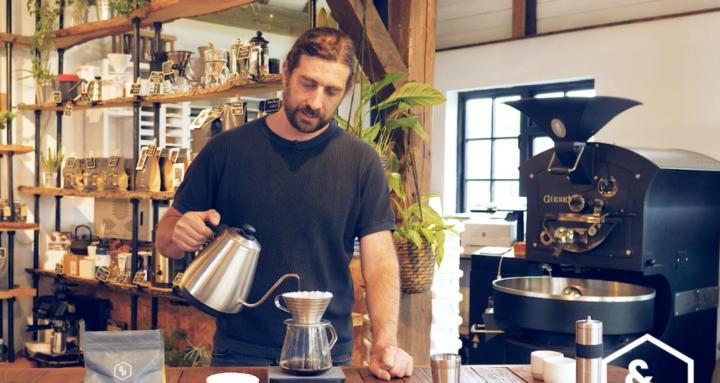🔥
Dec '24 • Green Coffee 🌱
What on earth is a 72-hour Anaerobic Natural Process?!
This got me thinking that there are quite a few farmers in the community now like Shahir and I'd like to encourage you all to bring what you do more to this community.
Lets face it, none of us would be able to enjoy coffee if it wasn't for the hard work of dedicated people like Shahir pushing forward with developing small lots of very interesting coffees.
So on the back of that I wanted to find out more about the Anaerobic Natural Process... so I asked our very own Bloss Specialty Coffee Academy AI Guide to teach me all about it...
This is what it came up with...
𝐓𝐡𝐞 𝟕𝟐-𝐡𝐨𝐮𝐫 𝐚𝐧𝐚𝐞𝐫𝐨𝐛𝐢𝐜 𝐧𝐚𝐭𝐮𝐫𝐚𝐥 𝐩𝐫𝐨𝐜𝐞𝐬𝐬 is a specialised method of coffee fermentation designed to enhance flavour complexity. It involves carefully controlling the conditions under which coffee cherries ferment to develop unique flavour profiles. Below is a breakdown of the process, and a few other points about it. I'd be really interested to hear from brewers and farmers alike who are familiar with this process and give me your feedback of what you like, dislike, do different, or disagree with...
///
𝐖𝐡𝐚𝐭 𝐢𝐬 𝐀𝐧𝐚𝐞𝐫𝐨𝐛𝐢𝐜 𝐅𝐞𝐫𝐦𝐞𝐧𝐭𝐚𝐭𝐢𝐨𝐧?
Anaerobic fermentation occurs in an environment without oxygen. For coffee, this involves sealing coffee cherries in airtight containers, which allows specific microorganisms to thrive. These microorganisms break down the sugars in the fruit, producing acids and other compounds that enhance the coffee's flavour.
///
𝐒𝐭𝐞𝐩𝐬 𝐢𝐧 𝐭𝐡𝐞 𝟕𝟐-𝐇𝐨𝐮𝐫 𝐀𝐧𝐚𝐞𝐫𝐨𝐛𝐢𝐜 𝐍𝐚𝐭𝐮𝐫𝐚𝐥 𝐏𝐫𝐨𝐜𝐞𝐬𝐬:
1. Selective Harvesting:
Only ripe coffee cherries are picked to ensure consistent fermentation. Unripe or overripe cherries are removed, as they can negatively affect the final flavour.
2. Initial Sorting:
Cherries are sorted by density and quality, often by using water tanks. Defective cherries float to the surface and are discarded.
3. Sealing the Cherries:
The whole coffee cherries are placed in airtight tanks or barrels. These containers are equipped with valves to allow the release of carbon dioxide (CO₂) that builds up during fermentation while keeping oxygen out.
4. Fermentation Period (72 Hours):
The cherries remain sealed for 72 hours. During this time:
- Microbial Activity: Yeasts, bacteria, and enzymes feed on the sugars in the coffee pulp, converting them into organic acids (like lactic and acetic acid) and other flavour-enhancing compounds.
- CO₂ Production: As fermentation progresses, CO₂ is released, which helps create a pressurised, oxygen-free environment.
- Temperature Control: The tanks are often kept in a cool environment to regulate fermentation speed and prevent overheating, which can spoil the beans.
5. Drying the Coffee:
After fermentation, the cherries are removed from the tanks and dried with the fruit still intact (natural process). This is typically done on raised drying beds or patios:
- The cherries are spread out in thin layers and regularly turned to ensure even drying.
- Drying can take 2–4 weeks, depending on weather conditions.
6. Hulling:
Once the cherries are fully dried, the outer layers (fruit and parchment) are removed to reveal the green coffee beans.
7. Resting and Cupping:
The beans are rested to stabilise their moisture content and then cupped (tasted) to assess their flavour profile.
///
𝐖𝐡𝐲 𝟕𝟐 𝐇𝐨𝐮𝐫𝐬?
The 72-hour period is carefully chosen to strike a balance:
- Too short, and the flavours may not fully develop.
- Too long, and the risk of spoilage or over-fermentation increases.
- This timeframe allows for optimal extraction of the sugars and acids in the coffee cherry.
///
𝐅𝐥𝐚𝐯𝐨𝐮𝐫 𝐏𝐫𝐨𝐟𝐢𝐥𝐞 𝐨𝐟 𝟕𝟐-𝐇𝐨𝐮𝐫 𝐀𝐧𝐚𝐞𝐫𝐨𝐛𝐢𝐜 𝐍𝐚𝐭𝐮𝐫𝐚𝐥𝐬
The extended fermentation and natural drying process create a highly complex flavour profile. Common characteristics include:
- Intense Fruitiness: Notes of tropical fruits, berries, or wine-like flavours.
- Lactic Acidity: A creamy, smooth acidity with a yogurt-like quality.
- Sweetness: Enhanced due to the breakdown of sugars during fermentation.
- Spices and Floral Notes: Subtle undertones of spices or florals may emerge.
- Body: Typically, a full-bodied, syrupy texture.
///
𝐂𝐡𝐚𝐥𝐥𝐞𝐧𝐠𝐞𝐬 𝐨𝐟 𝐭𝐡𝐞 𝐏𝐫𝐨𝐜𝐞𝐬𝐬
1. Risk of Over-Fermentation: Without careful monitoring, the coffee can develop off-flavours.
2. Specialised Equipment: Airtight tanks with valves are needed.
3. Time-Consuming: The process is labor-intensive and requires significant time and expertise.
4. Environmental Sensitivity: Temperature and humidity need to be carefully controlled throughout fermentation and drying.
///
𝐖𝐡𝐲 𝐈𝐬 𝐈𝐭 𝐏𝐨𝐩𝐮𝐥𝐚𝐫?
The 72-hour anaerobic natural process has gained attention among specialty coffee producers and consumers because it produces distinctive and memorable coffees that stand out in competitions or on cafe menus. It’s particularly popular with coffee enthusiasts seeking vibrant, experimental flavours.
12
28 comments
powered by

skool.com/bloss-coffee-academy-7629
Join a community of passionate coffee people! Improve your skills, from brewing basics to expert tips, and fuel your passion for all things coffee.
Suggested communities
Powered by
